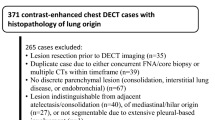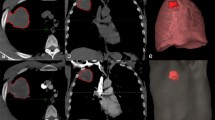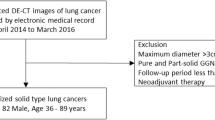Abstract
Objectives
To investigate whether radiomics on iodine overlay maps from dual-energy computed tomography (DECT) can predict survival outcomes in patients with resectable lung cancer.
Methods
Ninety-three lung cancer patients eligible for curative surgery were examined with DECT at the time of diagnosis. The median follow-up was 60.4 months. Radiomic features of the entire primary tumour were extracted from iodine overlay maps generated by DECT. A Cox proportional hazards regression model was used to determine independent predictors of overall survival (OS) and disease-free survival (DFS), respectively.
Results
Forty-two patients (45.2%) had disease recurrence and 39 patients (41.9%) died during the follow-up period. The mean DFS was 49.8 months and OS was 55.2 months. Univariate analysis revealed that significant predictors of both OS and DFS were stage and radiomic parameters, including histogram energy, histogram entropy, grey-level co-occurrence matrix (GLCM) angular second moment, GLCM entropy and homogeneity. The multivariate analysis identified stage and entropy as independent risk factors predicting both OS (stage, hazard ratio (HR) = 2.020 [95% CI 1.014–4.026], p = 0.046; entropy, HR = 1.543 [95% CI 1.069–2.228], p = 0.021) and DFS (stage, HR = 2.132 [95% CI 1.060–4.287], p = 0.034; entropy, HR = 1.497 [95% CI 1.031–2.173], p = 0.034). The C-index showed that adding entropy improved prediction of OS compared to stage only (0.720 and 0.667, respectively; p = 0.048).
Conclusions
Radiomic features extracted from iodine overlay map reflecting heterogeneity of tumour perfusion can add prognostic information for patients with resectable lung cancer.
Key Points
• Radiomic feature (histogram entropy) from DECT iodine overlay maps was an independent risk factor predicting both overall survival and disease-free survival.
• Adding histogram entropy to clinical stage improved prediction of overall survival compared to stage only (0.720 and 0.667, respectively; p = 0.048).
• DECT can be a good option for comprehensive pre-operative evaluation in cases of resectable lung cancer.



Similar content being viewed by others
Abbreviations
- ASM:
-
Angular second moment
- CT:
-
Computed tomography
- DECT:
-
Dual-energy computed tomography
- GLCM:
-
Grey level co-occurrence matrix
- GRAD:
-
Absolute gradient
- HIST:
-
Histogram analysis
- ICC:
-
Interclass correlation coefficient.
- OS:
-
Overall survival
- PET:
-
Positron emission tomography
- RL:
-
Run-length encoding
- ROC:
-
Receiver operating characteristic
- SUVmax:
-
Maximal standard uptake values
References
Siegel RL, Miller KD, Jemal A (2017) Cancer statistics, 2017. CA Cancer J Clin 67:7–30
Mitsudomi T, Suda K, Yatabe Y (2013) Surgery for NSCLC in the era of personalized medicine. Nat Rev Clin Oncol 10:235–244
al-Kattan K, Sepsas E, Fountain SW, Townsend ER (1997) Disease recurrence after resection for stage I lung cancer. Eur J Cardiothorac Surg 12:380–384
Uramoto H, Nakanishi R, Nagashima A et al (2010) A randomized phase II trial of adjuvant chemotherapy with bi-weekly carboplatin plus paclitaxel versus carboplatin plus gemcitabine in patients with completely resected non-small cell lung cancer. Anticancer Res 30:4695–4699
Gerlinger M, Rowan AJ, Horswell S et al (2012) Intratumor heterogeneity and branched evolution revealed by multiregion sequencing. N Engl J Med 366:883–892
Nitadori J-i, Bograd AJ, Kadota K et al (2013) Impact of micropapillary histologic subtype in selecting limited resection vs lobectomy for lung adenocarcinoma of 2cm or Smaller. J Natl Cancer Inst 105:1212–1220
Patnaik SK, Kannisto E, Knudsen S, Yendamuri S (2010) Evaluation of microRNA expression profiles that may predict recurrence of localized stage I non-small cell lung cancer after surgical resection. Cancer Res 70:36–45
Aerts HJ, Velazquez ER, Leijenaar RT et al (2014) Decoding tumour phenotype by noninvasive imaging using a quantitative radiomics approach. Nat Commun 5:4006
Straume O, Chappuis PO, Salvesen HB et al (2002) Prognostic importance of glomeruloid microvascular proliferation indicates an aggressive angiogenic phenotype in human cancers. Cancer Res 62:6808–6811
Maeda R, Ishii G, Ito M et al (2012) Number of circulating endothelial progenitor cells and intratumoral microvessel density in non-small cell lung cancer patients: differences in angiogenic status between adenocarcinoma histologic subtypes. J Thorac Oncol 7:503–511
Zhao YY, Xue C, Jiang W et al (2012) Predictive value of intratumoral microvascular density in patients with advanced non-small cell lung cancer receiving chemotherapy plus bevacizumab. J Thorac Oncol 7:71–75
Son JY, Lee HY, Kim JH et al (2016) Quantitative CT analysis of pulmonary ground-glass opacity nodules for distinguishing invasive adenocarcinoma from non-invasive or minimally invasive adenocarcinoma: the added value of using iodine mapping. Eur Radiol 26:43–54
Kim YN, Lee HY, Lee KS et al (2012) Dual-Energy CT in Patients Treated with Anti-Angiogenic Agents for Non-Small Cell Lung Cancer: New Method of Monitoring Tumor Response? Korean J Radiol 13:702–710
Bae JM, Jeong JY, Lee HY et al (2017) Pathologic stratification of operable lung adenocarcinoma using radiomics features extracted from dual energy CT images. Oncotarget 8:523–535
Sobin LH, Gospodarowicz MKCW (2009) UICC International Union Against Cancer. TNM Classification of Malignant Tumours. Lung and pleural tumours. Wiley-Blackwell, Oxford England, pp 138–146
Chae EJ, Song J-W, Seo JB, Krauss B, Jang YM, Song K-S (2008) Clinical Utility of Dual-Energy CT in the Evaluation of Solitary Pulmonary Nodules: Initial Experience. Radiology 249:671–681
Chae EJ, Kim N, Seo JB et al (2013) Prediction of Postoperative Lung Function in Patients Undergoing Lung Resection: Dual-Energy Perfusion Computed Tomography Versus Perfusion Scintigraphy. Investigative Radiology 48:622–627
Wu K, Garnier C, Coatrieux J-L, Shu H (2010) A preliminary study of moment-based texture analysis for medical images. Conf Proc IEEE Eng Med Biol Soc 2010:5581–5584
Soh L., C. T (1999) Texture analysis of SAR sea ice imagery using gray level co-occurrence matrices. IEEE Trans Geosci Remote Sens 37:780–795
Eo S, Kang HJ, Hong S, Cho HJ (2014) K-Adaptive Partitioning for Survival Data, with an Application to Cancer Staging
Portney LG, M.P. W (2000) Foundations of clinical research: applications to practice, 3rd edn. Prentice Hall, New Jersey
Yoon SH, Park CM, Park SJ, Yoon JH, Hahn S, Goo JM (2016) Tumor Heterogeneity in Lung Cancer: Assessment with Dynamic Contrast-enhanced MR Imaging. Radiology 280:940–948
Hayano K, Kulkarni NM, Duda DG, Heist RS, Sahani DV (2016) Exploration of Imaging Biomarkers for Predicting Survival of Patients With Advanced Non-Small Cell Lung Cancer Treated With Antiangiogenic Chemotherapy. AJR Am J Roentgenol 206:987–993
Huang Y, Liu Z, He L et al (2016) Radiomics Signature: A Potential Biomarker for the Prediction of Disease-Free Survival in Early-Stage (I or II) Non—Small Cell Lung Cancer. Radiology 281:947–957
Johnson TR, Krauss B, Sedlmair M et al (2007) Material differentiation by dual energy CT: initial experience. Eur Radiol 17:1510–1517
Swinson DE, Jones JL, Richardson D, Cox G, Edwards JG, O'Byrne KJ (2002) Tumour necrosis is an independent prognostic marker in non-small cell lung cancer: correlation with biological variables. Lung Cancer 37:235–240
Park SY, Lee HS, Jang HJ, Lee GK, Chung KY, Zo JI (2011) Tumor necrosis as a prognostic factor for stage IA non-small cell lung cancer. Ann Thorac Surg 91:1668–1673
Kilicgun A, Turna A, Sayar A, Solak O, Urer N, Gurses A (2010) Very important histopathological factors in patients with resected non-small cell lung cancer: necrosis and perineural invasion. Thorac Cardiovasc Surg 58:93–97
Kang M-J, Park CM, Lee C-H, Goo JM, Lee HJ (2010) Dual-Energy CT: Clinical Applications in Various Pulmonary Diseases. Radiographics 30:685–698
Parmar C, Rios Velazquez E, Leijenaar R et al (2014) Robust Radiomics feature quantification using semiautomatic volumetric segmentation. PLoS One 9:e102107
Velazquez ER, Parmar C, Jermoumi M et al (2013) Volumetric CT-based segmentation of NSCLC using 3D-Slicer. Sci Rep 3:3529
Liu J, Dong M, Sun X, Li W, Xing L, Yu J (2016) Prognostic Value of 18F-FDG PET/CT in Surgical Non-Small Cell Lung Cancer: A Meta-Analysis. PLoS One 11:e0146195
Satoh Y, Onishi H, Nambu A, Araki T (2014) Volume-based parameters measured by using FDG PET/CT in patients with stage I NSCLC treated with stereotactic body radiation therapy: prognostic value. Radiology 270:275–281
Kumar V, Nath K, Berman CG et al (2013) Variance of Standardised Uptake Values for FDG-PET/CT Greater in Clinical Practice than Under Ideal Study Settings. Clin Nucl Med 38:175–182
Nahmias C, Wahl LM (2008) Reproducibility of standardised uptake value measurements determined by 18F-FDG PET in malignant tumors. J Nucl Med 49:1804–1808
Funding
This research was supported by Basic Science Research Program through the National Research Foundation of Korea (NRF) funded by the Ministry of Science, ICT and Future Planning (grant number: NRF-2016R1A2B1016355).
Author information
Authors and Affiliations
Corresponding author
Ethics declarations
Guarantor
The scientific guarantor of this publication is Dr. Joon Beom Seo.
Conflict of interest
The authors of this manuscript declare no relationships with any companies whose products or services may be related to the subject matter of the article.
Statistics and biometry
One of the authors (Jung Bok Lee, PhD) has significant statistical expertise.
Informed consent
Written informed consent was waived by the Institutional Review Board.
Ethical approval
Institutional Review Board approval was obtained.
Methodology
• Retrospective
• Prognostic study
• Performed at one institution
Rights and permissions
About this article
Cite this article
Choe, J., Lee, S.M., Do, KH. et al. Prognostic value of radiomic analysis of iodine overlay maps from dual-energy computed tomography in patients with resectable lung cancer. Eur Radiol 29, 915–923 (2019). https://doi.org/10.1007/s00330-018-5639-0
Received:
Revised:
Accepted:
Published:
Issue Date:
DOI: https://doi.org/10.1007/s00330-018-5639-0




